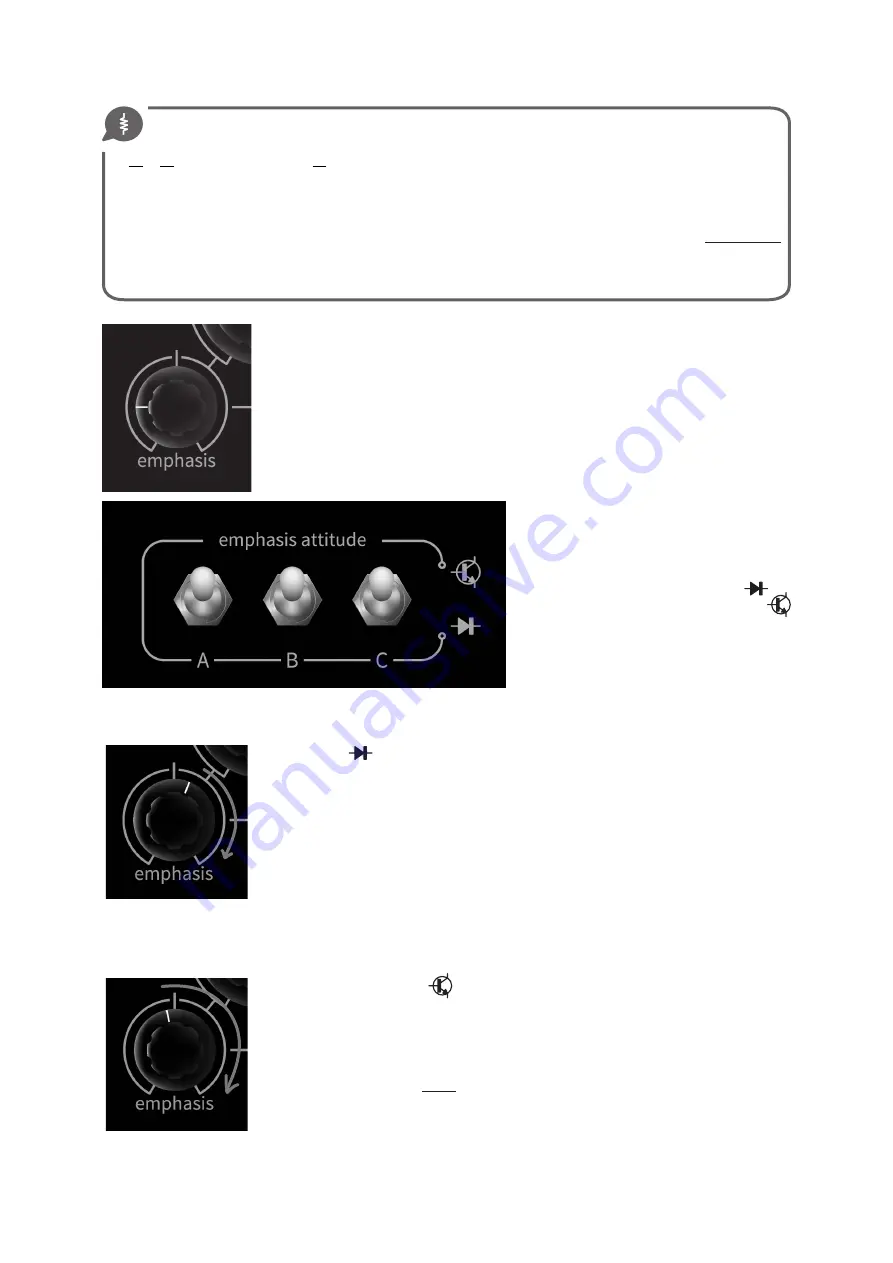
[
24
]
the Filters section
Emphasis mean
Resonance
. We chose this antiquated formulation to remember the
synthesizers of the 60s, when the word Resonance was not a standard yet.
Emphasis is a
level-controllable audio signal feedback across the filter’s path
. It can
produce some very interesting timbre variations that you can explore.
Use the
Emphasis
controls to increase the presence of the C
f
in the sound, or to create
whistles, wind, drops, goa-kick and a very unstable auto-oscillation.
In this filterbank the basic range of the three controls are heavily subjected to
Emphasis Attitude settings giving two deeply-diferent behaviors.
To give to our filterbank personality and
uniqueness we work a lot around this
Emphasis-related function that we label as
Emphasis Attitude.
This switch allows you to choose between
Classic Steiner's way, named Diode
and our personal design, the Transistor
(actually this is the BJT Npn transistor
symbol...)
NOTE: in the following "pot-pictures"
arrows indicate where the circuit generally
start the auto-oscillation behavior.
Classic way (
): this passive re-injection of signal into the audio path is the key to
obtain the classic synthesizers sound of sweeping filter but not only: it's useful for
increase the high frequency band levels to emphasize too dark tracks, making vibrating
and prominent Charleston lines or to shape the impact of weak snares.
The most important thing you can know about
this
Emphasis control (other kind of filter
have other kind of response) is that it increases the level of the output signal of many
dB, especially in the mid-frequency range, since it is limited only by passive resistors,
nothing else. In the next chapter you can find some graphs concerning this behavior
(page 27).
In addition to that it's very useful to know how Emphasis effects the resultant filter
slopes, making it more or less aggressive on the harmonic contents. Generally speaking, in Vertice MORE EMPHASIS
= MORE AGGRESSIVE SLOPES
Alternative Emphasis way (
): in order to tame the too much dynamics that the Classic
Emphasis way has, something funny but not so frequently musically usable, in this long year
of Vertice re-design work we projected our own personal resonance way. The selected simbol
to label it is the transistor because two active silicon transistors are used to compress and
distort audio signal traveling into them.
This is maybe the first time a dynamic and tonal distortion is dedicated specifically to the
resonance path, that is only a part of the signal in the filterboard, and that is SUMMED into it,
giving unmistakable nuances.
Furthermore this more controlled resonance path give a very useful static auto-oscillation,
something that allows you to use Vertice also like a triple oscillator, if you dare.
You have to know that this Transistor way, like so much things in Vertice, is very sensitive to the incoming signal level.
Moderate the input if you want the Transistor Emphasis "VCO effect" very prominent and "in face" or drown it into a sea
of very loud wave (maybe using also the overload funcion) to get out more nasty nuances.
Filters output phases
In this particular case the phase shift between the input and the output signal is equal to the vector of
−
π
2
+
π
4
= −
90
°
+
45
°
= −
π
4
= −
45
°
In other configurations phase differences introduced by the capacitor's constructive characteristics, which
are not small at all, show themselves in various way but we ignored here the subject for evident lack of need.
These phase changes are the reason why over-aggressive cut slopes (e.g. 36 or more dB/oct) are less musical
than a smooth one and they can be sources of unwanted cancellations and other audio artifacts. This is true
for all the processes that involve filters, especially analog or digital equalizers, from which we generally want
strictly functional, not creative, performances, so smooth, clean and transparent.
Summary of Contents for Vertice
Page 1: ...USER S MANUAL...
Page 2: ......
Page 5: ...Dedicato a Walt Bruno e Lorenzina con immenso amore Stefano...
Page 68: ...Ratio et Cogitatio Unicam Fidem Sunt...
Page 69: ......
Page 70: ......















































